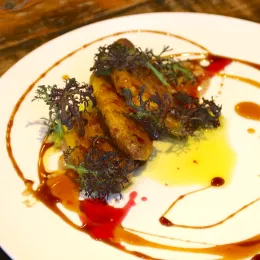Each fall and winter we get to play with the full bounty of root vegetables, and I love experimenting with new ways to use them. I use the usual suspects we expect on the dinner table: sweet potatoes, yams and maybe the occasional beet, but I also tend to lean toward the lesser-known root vegetables such as horseradish, celery root and Jerusalem artichoke.
All of these can either stand alone in their glory or act as wonderful accompaniments to a main dish.
What Are Root Vegetables?
Root vegetables are the underground parts of plants that can be eaten. Think carrots, potatoes, sweet potatoes, turnips and beets to name a few.
Since they're grown underground, root vegetables already contain a ton of nutrients from the soil in which they are grown. Carbohydrates, sugars and starches can be extracted from some root vegetables to make delicious concoctions like syrups, molasses or natural vegetable glazes.
For example, last fall I was studying yams, experimenting with all the ways I could utilize the tubers. In one instance, I peeled a yam, put the peel shavings into a sauce pot and then roughly chopped the yam itself. I filled the pot with enough water to cover the yam and slowly reduced it down to a molasses. The sugar and the starches in the yam made it thick and sweet, and the peelings provided a gorgeous color. I then used the yam molasses in many applications:
- As a sweet, earthy glaze for meats
- As a delicious drizzle on top of ice cream
- As an ingredient in a sweet potato pie
Once I even smoked the raw yam in advance, then peeled and boiled so that it had a slightly smoky nuance to the finished product. This is a no waste recipe, too — the pulp can be pureed and served with a little salt, butter and a crumble of toasted seeds on top for a delicious, easy side dish.
This season, don’t be afraid to experiment with new seasonal ingredients.
When conducting my experiments, absolutely nothing goes to waste. Sometimes, I even fold the pulp into pancake batter! So this season, don’t be afraid to experiment with new seasonal ingredients.
Cook with winter vegetables in Plant-Based Culinary Arts
Here are a few recipes that you can try at home.

Ingredients
For the Yam Molasses:
- 1 large African yam
- 2 small sweet potatoes
- 1 pound (455 g) dark brown sugar
- 1 tablespoon ground allspice
- 2 tablespoons kosher salt
- 1 teaspoon black pepper
- 1 fresh bay leaf
For the Roasted Carrots with Buckwheat:
- 1 bunch baby carrots, with the tops intact
- 1 small handful frisée greens
- Juice from 1 lemon
- 3 tablespoons olive oil, divided
- 2 tablespoons kosher salt
- 1 teaspoon ground cumin
- 1 teaspoon ground allspice
- 1 teaspoon ground ginger
- 2 tablespoons olive oil
- 3 tablespoons butter
- 2 shallots, thinly sliced
- 1 pint (54 g) oyster mushrooms, trimmed and cleaned
- 1 tablespoon thyme, finely chopped
- Salt and pepper, to taste
- 1 cup (175 g) buckwheat groats, cooked according to package directions
- Yam molasses (recipe above) and lemon juice for serving
Directions
For the Yam Molasses:
- Peel the yam and reserve the peels. Heat an oven to 350 F°, and roast the peeled yam until tender, about 40 minutes.
- Peel the sweet potatoes and reserve the peels. Cut the raw sweet potatoes and roasted yam into rough chunks, and add them (and the peels) to a large Dutch oven or heavy-bottomed pot. Fill with enough water to cover everything with 1 inch of water. Add the remaining ingredients to the pot, cover, and bring to a boil over high heat. Once boiling, reduce the heat to medium, remove the cover, and simmer for 1 hour.
- After an hour, use a hand strainer or spider to remove all of the yams and peelings from the liquid and discard them. Return the liquid to medium-low heat, and slowly reduce until the mixture becomes thick and dark brown in color but still translucent, around 1 1/2 hours. The starches from the tubers should be enough to thicken the liquid, but you can make a cornstarch slurry to help it along if need be. The flavor should be very potent and a delicious complement to everything from meat to bread to dessert.
For the Roasted Carrots with Buckwheat:
- Wash and scrub the carrots, including the tops. Remove the tops. Cut one third of the carrot tops into 1-inch (2.5 cm) pieces. You can save or discard the rest. Toss the chopped tops with frisée greens and dress with lemon juice and 1 tablespoon of olive oil. Refrigerate until ready to use.
- Place the carrots in a bowl and toss with the remaining 2 tablespoons of olive oil, the salt and the spices. Place on a baking tray in a single layer, and roast in a 350 F° (175 C) oven for 25 minutes or until tender. Let cool at room temperature.
- In a cast-iron skillet or sauté pan, add the olive oil and butter and heat over medium-high heat. Once melted, add the shallots and stir frequently until shallots are translucent, about 3 minutes. Add the mushrooms, thyme, and salt and pepper to taste. Stir frequently until the mushrooms are tender, about 4 minutes.
- Add the buckwheat, turn the heat to high, and stir continuously, letting the buckwheat toast. Cook for about 6 minutes, then transfer to serving plates. Top with the roasted baby carrots and drizzle with yam molasses and fresh lemon. Top with the carrot top/frisée salad.
Learn more about buckwheat and consider serving these dishes with Chef Chris' winter salad.




